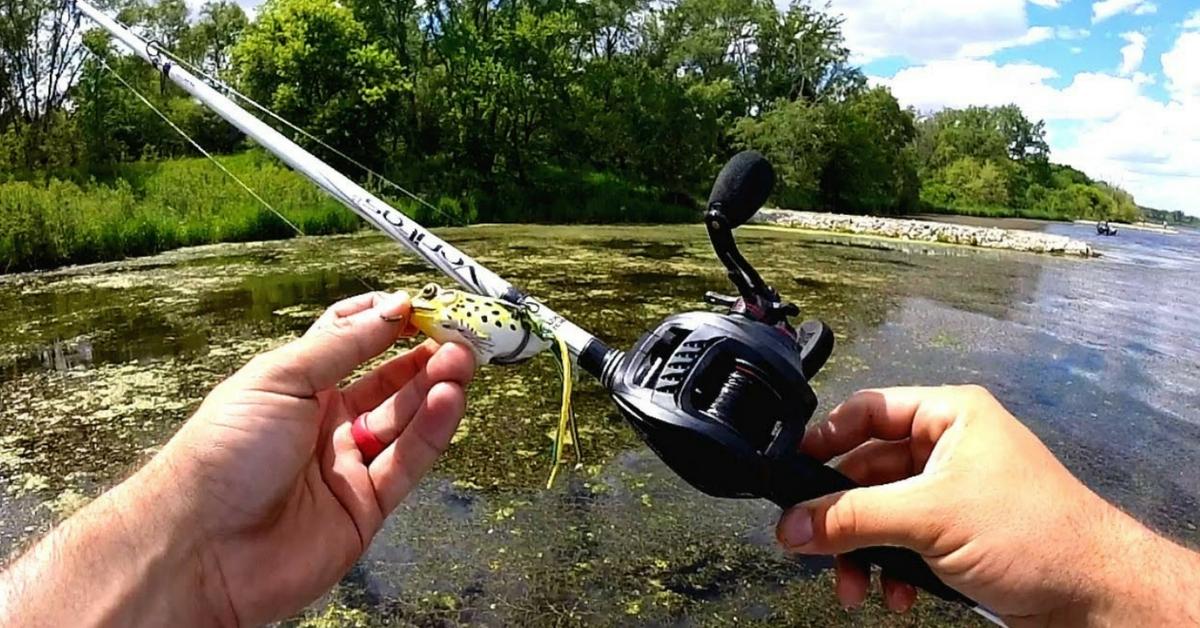All There Is To Know About Frog Fishing For Bass
There is arguably no more exciting way to catch bass than having a giant largemouth blow up on a topwater frog. Frog fishing for bass offers an exhilarating, fast-paced, sight fishing opportunity that pushes your anticipation to the limit. Sometimes it can even be the most productive way to catch bass. Frog fishing can be as simple as it seems, but there are a few tips to try next time you find yourself dragging the critter across a pond, lake or river.Let’s start with the frog itself. There are a couple types of frog lures that are available to the angler. The most widely used is the hollow body frog. Almost all hollow body frogs are a piece of soft rubber molded in the shape of a frog around two hooks pointed upward, and two silicone skirts protruding as legs. I always find the legs on these frogs too long directly out of the package so I trim them down to look more natural.
Another type is the soft body frog made of a soft plastic material, which can be rigged weedless with an extra wide gap or swimbait hook. These are often reeled along the surface as the legs lick (like a swimbait tail) drawing aggressive fish to react.Hard body frogs can take the shape of shallow running crankbaits, topwater poppers, and Spook-style walking baits. These are generally better frog fishing for bass in open water situations because they aren't weedless.
Where to fish the frog? It is possible catch bass on frogs in any water conditions, however there are certain times and places to focus on throwing this bait. Frogs inhabit vegetation, where bass are accustomed to feeding on them, so it is important to key in on these areas. Vegetation varies from fishery to fishery, but bass will readily feed on the slimy critters in any type of weeds. The best vegetation takes the form of reeds, standing grass, lily pads, and algae mats known as ‘scum’, ‘muck’, or ‘cheese’. Don't be afraid to go frog fishing for bass near woods, docks, or other forms of shallow cover, though.Remember that frogs are weedless, so cast directly into the vegetation without fearing the thickest cover. Cast inches from shore if there is a solid bank bordering the weeds. It is not a big deal to land your frog on the land. Simply pop it into the water like a frog departing from shore. Allow three or four seconds to pass after the initial landing. Blowups often occur immediately, so be vigilant. Take some time to discover what you are comfortable with when frog fishing for bass, as with any style of fishing, it is very important to have confidence in your presentation.Popular retrievals are popping, walking, skittering, or a combination of them all. Drag the frog over the vegetation with patience. If you are missing a lot of bass following the explosion, you should consider slowing down your retrieval to give the bass more time to locate the bait.
Work the frog across holes in matted vegetation, but do not let your frog sit in these holes because the bass can take all the time it wants to inspect your bait. Rather, work it quickly across the barren patches and let it rest on the edge of the mat, like a frog that thinks it has reached safety. If you are swimming in shark infested waters, you would most likely not want to float on your back soaking in the rays. Naturally, you would swim to shore or to the nearest structure.Frogs have the instinct to do the same. In open water you can retrieve a frog by walking it. Keep some slack line and lightly snap your rod away from the frog in a rhythm to create the side-to-side action that drives bass insane. It is important to work the frog with your rod tip lowered. If you work the frog with your rod tip up in the air, you will find yourself struggling to set the hook on takes.There are a number of ways that a bass will hit a frog, such as a quick suck, a blowup, or a boil. Especially for anglers new to frogging, it is suggested that you wait patiently after the hit before setting the hook to the side in one aggressive sweep. I personally advise new anglers frog fishing for bass to count to three seconds before setting the hook. This is much easier said than done, but once you acquire some experience, setting the hook will become natural.
It is important to learn to feel the weight of the fish before setting the hook rather than swinging on every bite. Do not be discouraged if you miss any fish on frogs, because it happens to everyone. I’ve heard pros say they aim for 75% of blowups leading to fish catches. Throw your bait right back to the spot of the hit and many times they will hit again.The possibilities are endless with the frog. Once you catch a bass on a frog, you will not want to catch them any other way for a while. Put these tips to use and explore with your own tactics. You will certainly coax a giant into destroying your bait after some quality time spent on the water.This post was guest written by Chris Trianosky of the Penn State Bass Fishing Team.
Updated January 22nd, 2021 at 2:54 AM CT


